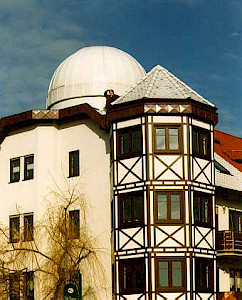The Trebur Astronomy Foundation operates one of the largest telescopes in Germany. The Treburer-1 meter-telescope is used for scientific work as well as for guided tours for visitors. It is one of the largest publicly accessible telescopes in Europe, which is also used for visual observation.
According to the statutes of the foundation, the purpose of the Trebur Astronomy Foundation is to promote science and research in the field of astronomy and astrophysics. The foundation realizes this purpose in particular by scientific projects as well as by information of the interested public with the aim to interest especially young people in the field and thus to attract young scientists.
 The dome of the public observatory, which is situated in the heart of Trebur, is visible from quite a distance from the outlying fields surrounding the village. The dome has a diameter of 5.4 meters and houses one of the largest privat telescopes of the world.
The dome of the public observatory, which is situated in the heart of Trebur, is visible from quite a distance from the outlying fields surrounding the village. The dome has a diameter of 5.4 meters and houses one of the largest privat telescopes of the world.
The original intention of starting this excellent project was to offer a worthwhile cultural attraction to the residents of Trebur and neighbouring areas. This project was initialised and founded by Michael Adrian and with the expert assistance of Jürgen Bommarius, Dr. Johannes Ohlert and Horst Tremel, planning and implementing these plans began in summer 1995. These included decisions as to which dome, telescope, accessories, computing equipment, and educational facilities would best serve the public of the Rhein-Main area.
This was the announcement of the founding of the Trebur Astronomy Foundation and the construction of the large telescope in the June 1997 issue of the journal of the Vereinigung der Sternfreunde e.V.
In the meantime, more than 25 years later, a lot has happened at the foundation. While the focus was initially on the T1T, the “Astronomical Lectures” series was launched at the Michael Adrian Observatory in 2000. In 2010, the “Planet Trail” was created on the outskirts in the Rüsselsheim direction.
In addition to public relations work, the results of scientific work at the observatory were also incorporated into numerous publications.
As a third pillar, the construction of astroparc could then begin in 2024, after a planning and approval procurement phase lasting over ten years. It is expected to open in the second half of 2025.
Below you will find links to further details of our three pillars.